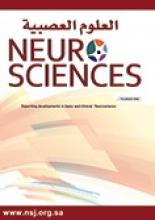Abstract
OBJECTIVE: To describe the clinical profile, and identify its risk factors, of cerebral palsy (CP) as seen in a cohort of consecutive Saudi children aged between one and 3 years of age prospectively over a one-year period.
METHODS: Saudi children aged 1-3 years with CP (diagnosis based on specified criteria) were selected from children presenting to the Neurology service at the King Fahd Hospital of the University, Al-Khobar, Kingdom of Saudi Arabia with delayed milestones, seizures, mental retardation and difficulty with walking and evaluated at 3-monthly intervals for one year from January to December 2000. Information on gestation duration, labor and delivery, birth weight and the medical history of the mothers was obtained. Cranial computerized tomography and electroencephalography were carried out in addition to baseline investigations (toxoplasmosis, other, rubella, cytomegalovirus, and herpes simplex virus serology, serum lactate, pyruvate, amino acid screen, thyroid function tests, and chromosome analysis). Somatosensory, molecular genetics and muscle biopsy for histopathologic and histochemical studies were not performed in any of the patients.
RESULTS: One hundred and eighty-seven children with CP were seen during the study period: 109 males (mean age 20.3 +/- 8.69 months); 78 females (mean age 20.6 +/- 8.55 months). Seventy-three had microcephaly (<5th percentile) with a mean head circumference of 44.5 +/- 3.69 cms for males and 43.0 +/- 4.16 for females. The main symptoms were inability to walk independently (54%), delayed speech (52%) and seizures (45%). The main neurologic features were motor weakness (85%), spasticity (60%), language dysfunction (42%), mental retardation (31%) and head lag (30%). A history of previous CP in the family was obtained in 8 patients (4%) but none of them had other features of hereditary spastic paraplegia. Electroencephalography abnormalities, present in 113 (73%) were more frequent in those without seizures than with seizures. Cranial computerized tomography abnormalities were mainly cerebral atrophy (60%) and hydrocephalus (53.7%). Twenty-five percent were from twin pregnancies; 56 (34%) were of low birth weight, 20% were pre-term deliveries, birth asphyxia was present in 165 and breech presentation was encountered in 8%.
CONCLUSION: The main risk factors identified were twin pregnancy, pre-term delivery, prolonged labor, low birth weight and a history of previous CP in the family. Our findings suggest that improved maternal and childcare particularly in the ante and perinatal periods may reduce the incidence of CP in this environment.
- Copyright: © Neurosciences
Neurosciences is an Open Access journal and articles published are distributed under the terms of the Creative Commons Attribution-NonCommercial License (CC BY-NC). Readers may copy, distribute, and display the work for non-commercial purposes with the proper citation of the original work.






